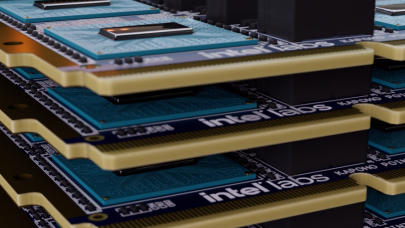
Intel Labs Launches Neuromorphic ‘Kapoho Point’ Board
September 28, 2022
Over the past five years, Intel has been iterating on its neuromorphic chips and systems, aiming to create devices (and software for those devices) that closely Read more…

Neuromorphic Computing to Assist Children Who Use Wheelchairs
August 20, 2020
Intel’s neuromorphic chip has learned to smell, learned to touch – and now, it’s here to help. The chip, which mimics the behavior of the human brain, is Read more…

Earthquake Simulation Scales to 8.6 Petaflops
August 14, 2014
Intel Labs Vision Stategist Divya Kolar explores how supercomputing is helping society prepare for earthquakes. Current earthquake early warning systems are v Read more…

The Weekly Top Five – 02/03/2011
February 3, 2011
The Weekly Top Five features the five biggest HPC stories of the week, condensed for your reading pleasure. This week, we cover the computing power on display at SC10's Student Cluster Competition; the University of Portsmouth's new supercomputer; IBM Watson's SUSE Linux platform; multicore advances at North Carolina State; and Intel's new approach to university funding. Read more…

Terascale Memory Challenges and Solutions
December 6, 2010
In contrast to the previous decade, CPU clock rates are scaling slower over time due to the power constraints. However, the number of transistors per silicon area continue to increase roughly at the rate of Moore's Law. Therefore, CPUs are being designed and built with an increasing number of cores, with each core executing one or more threads of instructions. This puts a new kind of pressure on the memory subsystem. Read more…

- Click Here for More Headlines

Whitepaper
Transforming Industrial and Automotive Manufacturing
In this era, expansion in digital infrastructure capacity is inevitable. Parallel to this, climate change consciousness is also rising, making sustainability a mandatory part of the organization’s functioning. As computing workloads such as AI and HPC continue to surge, so does the energy consumption, posing environmental woes. IT departments within organizations have a crucial role in combating this challenge. They can significantly drive sustainable practices by influencing newer technologies and process adoption that aid in mitigating the effects of climate change.
While buying more sustainable IT solutions is an option, partnering with IT solutions providers, such and Lenovo and Intel, who are committed to sustainability and aiding customers in executing sustainability strategies is likely to be more impactful.
Learn how Lenovo and Intel, through their partnership, are strongly positioned to address this need with their innovations driving energy efficiency and environmental stewardship.
Download Now
Sponsored by Lenovo
Whitepaper
How Direct Liquid Cooling Improves Data Center Energy Efficiency
Data centers are experiencing increasing power consumption, space constraints and cooling demands due to the unprecedented computing power required by today’s chips and servers. HVAC cooling systems consume approximately 40% of a data center’s electricity. These systems traditionally use air conditioning, air handling and fans to cool the data center facility and IT equipment, ultimately resulting in high energy consumption and high carbon emissions. Data centers are moving to direct liquid cooled (DLC) systems to improve cooling efficiency thus lowering their PUE, operating expenses (OPEX) and carbon footprint.
This paper describes how CoolIT Systems (CoolIT) meets the need for improved energy efficiency in data centers and includes case studies that show how CoolIT’s DLC solutions improve energy efficiency, increase rack density, lower OPEX, and enable sustainability programs. CoolIT is the global market and innovation leader in scalable DLC solutions for the world’s most demanding computing environments. CoolIT’s end-to-end solutions meet the rising demand in cooling and the rising demand for energy efficiency.
Download Now
Sponsored by CoolIT
Advanced Scale Career Development & Workforce Enhancement Center
Featured Advanced Scale Jobs:
HPCwire Resource Library
HPCwire Product Showcase
© 2024 HPCwire. All Rights Reserved. A Tabor Communications Publication
HPCwire is a registered trademark of Tabor Communications, Inc. Use of this site is governed by our Terms of Use and Privacy Policy.
Reproduction in whole or in part in any form or medium without express written permission of Tabor Communications, Inc. is prohibited.
























